Art Catharsis at Time of Covid 19
Kofi Fosu Forson
September 2020
 Great Weather for Media, 2020, Oil Pastel, Graphite, 10 in x 14 in
Great Weather for Media, 2020, Oil Pastel, Graphite, 10 in x 14 in
While the “art world” basically shut down during the pandemic, artists had to keep themselves & community creatively active. We recently featured on Arteidolia a series of interviews by Colette Copeland, where she addressed artist couples living under quarantine and how this impacted their daily artistic practices. Since publishing the poetry of writer, poet and playwright Kofi Fosu Forson in swifts & slows: a quarterly of crisscrossings, I’ve been following his Facebook page, where these very intriguing, passionate & candid paintings keep surfacing. Forson captures a mysterious, but revealing deepness with each one portrayed. Curious as to how they evolved, I asked Kofi if he’d like to write about it.
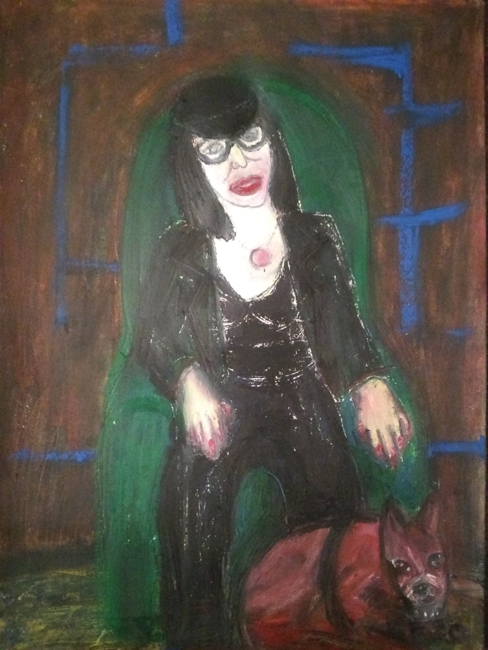 Puma, 2020, Oil Pastel, Graphite, Crayon 10 in x 14 in
Puma, 2020, Oil Pastel, Graphite, Crayon 10 in x 14 in
ART CATHARSIS AT TIME OF COVID-19: REFLECTIONS ON SELF-IDENTITY
The world is experiencing a crisis.
At this point, how do we build a communal atmosphere, love of the community and its people, further a cause for activism to promote unity, yet pursue interpretation of beauty in art?
Much as the world is seeing its share of protests, life goes on accordingly, people are getting married, children are being born, unfortunately given the reality of COVID-19, people are passing away at an alarming rate.
The manifest then being, how do we as a community of people channel that sense of togetherness and appreciation for living?
Given the corona virus and the necessary lock-downs, the world has coalesced on the theme and topic of safety. How do we find means whereby, our collective consciences meet at a point to communicate?
Social media has become such a place. More so the Zoom phenomenon has encouraged productivity for people to conduct business, as well as immediacy of family and friendly celebrations and gatherings.
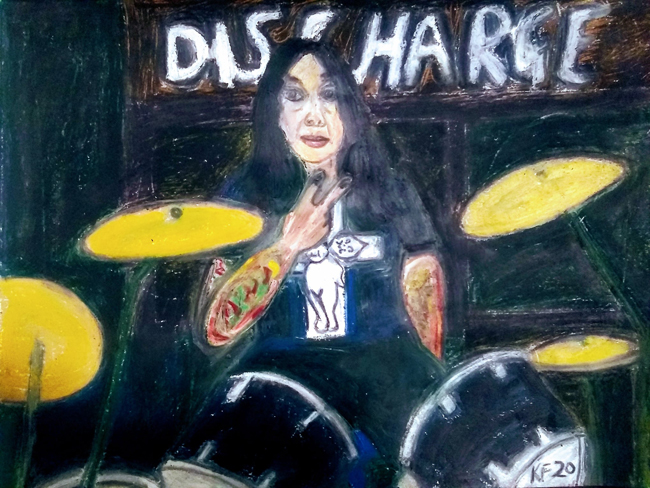 April Star, 2020, Oil Pastel, Graphite, 10 in x 14 in
April Star, 2020, Oil Pastel, Graphite, 10 in x 14 in
What is the artist’s role, first as a need for art appreciation, then as a way to unite the communities online, knowing the division politically and socially?
In the early 2000’s, the world experienced a post-conscious awareness when our collective mindset pushed forward from the angst of the grunge movement, political divide expressed through Rock N’ Roll music, from bands like Rage Against the Machine. Fetishism influenced variations on the element of porn, most specifically, internet porn. Other elements of the prefix “post” were common, for example, post-gender and post-feminism.
Centrally, the world met its discord and alliance throughout the virtual sphere. Accounts like MySpace, predated Facebook. The general perception was to find space where people all over the world could meet to chat, interact, exchange ideas on art, music, or something as commonplace as to find love.
Performative art, theatrical aspirations, basically the human body in motion had been redefined to find its calling on stage, screen, and that of the internet.
Soho performance spaces had opened up to meet the energy of (Off) Off-Broadway Theater. The Wooster Group, an experimental theater company known for its production of original plays, was steps ahead. The Riant Theater, where I began a career as writer and director, existed on the edge of Tri-Beca. Nuyorican Poets Cafe welcomed spoken word poets and other performers to its East Village location.
Soho was meeting the last call of art revelers to the many galleries, as art left for Chelsea. Among the art galleries that existed in Soho was Eickholt Gallery, a 5,000 square foot gallery located on the third floor of a building North of Canal Street. I served as an interning Press Officer, and as a co-writer of the gallery’s manifesto, helped with its affiliation with the Liverpool Biennial.
This became the beginning of my experience with communication within the virtual world. The cultural initiative, Transvoyeur, made up of Liverpool artists, consulted me on numerous projects, among them was Gender, Space, Art and Architecture, a virtual conversation between me and Liverpool artist, Daiva Gauryte. It opened the channel between me and several other artists and curators from Liverpool. Jo Derbyshire, a curator, assembled my prints of drawings in a one-man show, “From New York to Liverpool and Back Again” (Femmes du Futur), at Loft Space Programme in Liverpool.
I was then invited to join a growing number of people with profiles on Facebook. Wavelength for communication reflected the orgiastic art environment inspired by gender and sexual politics. People on Facebook known as “friends” interacted trans-continentally, with the purpose of engaging in trysts.
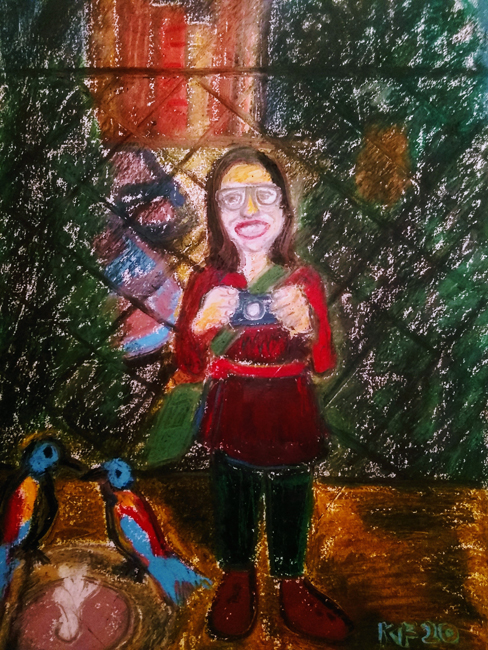 Two Birds on a Fountain, 2020, Oil Pastel, Graphite, 10 in x 14 in
Two Birds on a Fountain, 2020, Oil Pastel, Graphite, 10 in x 14 in
Noah Becker’s Whitehot Magazine picked up on this craze when he got the idea to market art writing by promoting the talents of art writers from all over the world. I joined Whitehot, and specialized in interviewing avant-garde artists/heroes from the Neo-Expressionist and Pop Art scene in the East Village which covered music, art and film.
Facebook reached a climax with the 2016 American Presidential election. Gradually the art reverence over time had met a political change. The election fueled it further. Topics of racism, nationalism and partisan politics overwhelmed the media. It was met with thread conversations on Facebook, which echoed the division locally, internationally and within art communities.
The deaths of two important members of the art community, muralist and installation artist, Dianne Bowen and painter, Joe Heaps Nelson, was a continuation of death in pop culture of important musicians which began with the deaths of David Bowie and Prince.
Cathartically, people were drawn inwardly, some who challenged notion of queerdom, transgenderism, and others who saw the need to decolonize from their histories.
 Mind-bender II, 2020, Oil Pastel, Graphite, Charcoal, 11 in x 14 in
Mind-bender II, 2020, Oil Pastel, Graphite, Charcoal, 11 in x 14 in
The hashtag #decolonize was trending at the time. I became drawn to the many people who were on a mission to challenge their identities. I had read Ekow Eshun’s “Black Gold of the Sun”, a memoir which reflected his dual cultures from Ghana and Great Britain. I saw a parallel between my Ghanaian origins and New York City residence.
There had been moments in my life when I had questioned my identity or sense of blackness. The word “decolonize” made me delve into my associations with those in what I considered to be a white-art-world. It gradually caused a shift in my friendships off-line with those in the art and poetry community, as well as my “friends” on Facebook.
I had gained a spiritual awareness and began what I called “intellectualizing” of my body. It brought me to Twitter where I began tweeting philosophies which had originally been entered into my blog, Black Cocteau. I became a part of an academic community of anti-racists and educators who taught courses in post-colonialism and those in England, including Jo Shah, an academic whose purpose is basically fighting against injustice, and one person in particular, Shona Hunter, a lecturer on institutional whiteness.
As Twitter turned into an oasis for philosophizing and building of newer friendships, I gained an acceptance within this newfound community. It freed me from the toxicity present between me and my Facebook friends. I found reasons to come back to Facebook, especially when I began a Facebook friendship with musicians Dan E. Zanes and his wife Claudia.
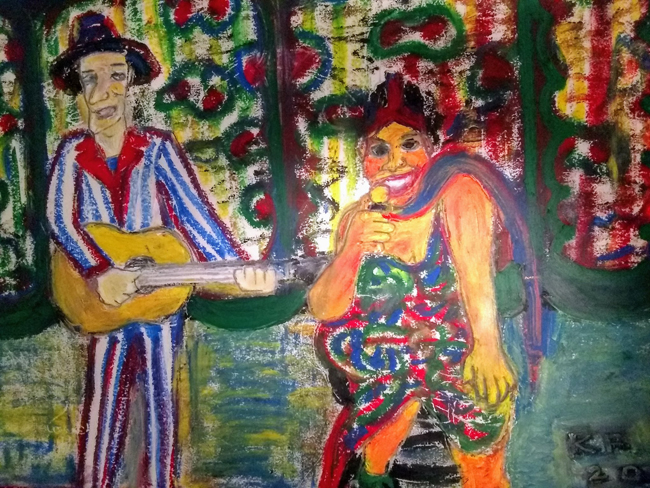 Dan and Claudia Zanes, 2020, Oil Pastel, Graphite, 10 in x 14 in
Dan and Claudia Zanes, 2020, Oil Pastel, Graphite, 10 in x 14 in
Recent months have seen the world struggle with the COVID-19 virus; hence, pulled us into a state of quarantine. At the same time there has been an ongoing political unrest which started with the murder of George Floyd, bringing on the consciousness and need for justice around the world. All the while, the chanting that black lives matter became a rallying cry.
It drew me back into the soul-searching for my black identity, a reality hyper-colonized by Euro-American art and Rock N’ Roll. After I read Eddie Glaude Jr.’s book, “Begin Again”, I discovered a truth in the ongoing struggle for African-Americans to gain liberty in the United States.
At the center of Eddie Glaude, Jr.’s book is Dorothy Counts, one of the first black students admitted to Harry Harding High-School in Charlotte, North Carolina, in an attempt to desegregate schools in that city. He recalls how Dorothy Counts was spat upon and jeered, nothing like the warmth with which I was welcomed to my grade school as a foreigner.
The African diaspora had become renewed in my thinking. How do I find commonality in the assertion of the immigrant struggle and that of the African-American, searching for placement in America.
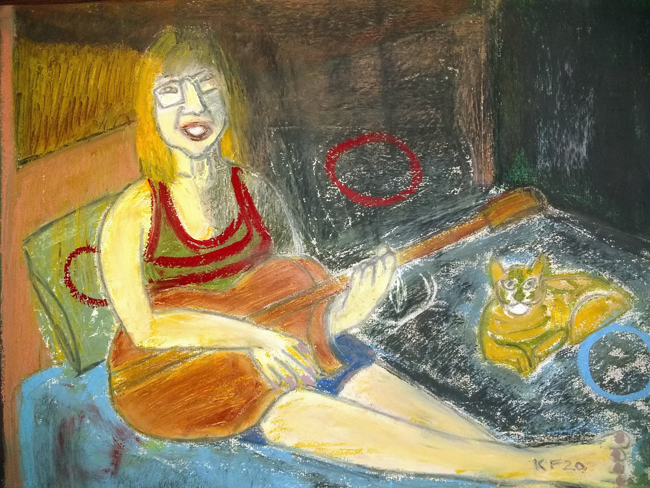 Su with a Guitar, 2020, Oil Pastel, Graphite, 10 in x 14 in
Su with a Guitar, 2020, Oil Pastel, Graphite, 10 in x 14 in
Overwhelmingly, the virus and its death toll, experience of quarantine, division among the races, and our social isolation, which was reflected in Dan and Claudia Zanes posting a video daily of their performance of a song in a series called Social Isolation Song Series, inspired me to do drawings of my social media followers and “friends”, expressing commonality as virtual beings, our mutual conscience in our battle with the virus, and a mending of fences between me and those I had shifted from in my attempt to reflect upon my blackness.
The conclusion on the matter was an acceptance of my Ghanaian culture, overwhelmed by my cultural experience in America. These drawings were a culmination of my participation in the workshop Artist’s Way. The twelve week course featured exercises such as morning pages and artist dates, and with guidance from a moderator, Christina Germaine, we reflected on the tasks and themes in the Julia Cameron book, “The Artist’s Way.”
After ten or more years not making any professional drawings or paintings, I quietly prepared to do just that. During moments of stress, I experimented with using my left hand to draw, an original ability which I was chastised for in my youth by my father. He forced me to use my right hand. This has been how I have used my hand to express myself. Gradually I used my left hand to draw objects placed as examples of still-life. It strengthened my vision and enabled me to pursue narratives for composition. My exploration into ambidexterity has helped me deal with the on-comings of fear which has haunted me psychically. The idea of envisioning something, applying myself and making a work of art out of it is truly transcendental in my life.
I began by posting old drawings from time when I made drawings of muses and slowly found my way into galleries. This gained traction on Facebook, and it inspired people to express interest in my work. When I posted my first drawing in this new series, it revealed how people loved to see themselves reflected in art. I tagged them in the post. It enabled them to be alerted to the post. What followed was their expression of absolute joy and gratitude, somehow rekindled friendships that had been long lost, or revealed to them another one of my talents as a multi-disciplinary artist.
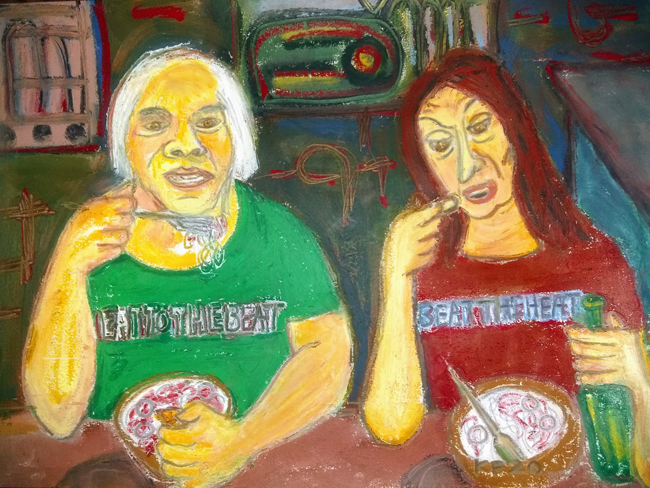 Eat to the Beat, 2020, Oil Pastel, Graphite, 10 in x 14 in
Eat to the Beat, 2020, Oil Pastel, Graphite, 10 in x 14 in
Among those in the drawings are Peter Carlaftes and Kat Georges, husband and wife team of Three Rooms Press, “Eat to the Beat”; Puma Perl, poet and performer, “Puma”; Su Polo, poet, singer/songwriter, “Su with a Guitar”; Francine Witte, poet and flash-fiction writer, “Two Birds on a Fountain”; Jane Ormerod, David Lawton, Peter Darrel, part of the masterminds behind the press, “Great Weather for Media”; Phillip Giambri, poet and spoken word artist, also known as The Ancient Mariner, “Dominican Nights”; April Davis, former rock music journalist, artist, and jewelry designer, “April Star”; and Dan E. Zanes and Claudia Eliza Zanes, husband and wife musicians, “Dan and Claudia Zanes”.
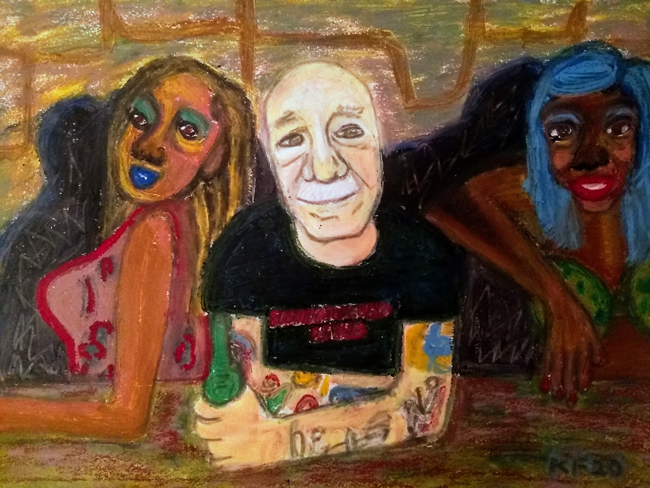 Dominican Nights, 2020, Oil Pastel, Graphite, 10 in x 14 in
Dominican Nights, 2020, Oil Pastel, Graphite, 10 in x 14 in
The process for making art has taken on a new meaning. Quarantining has been a form of isolating from the rigmarole of outside activities, time when I was overwhelmed by undue stress in managing of a life removed from the normalized art and poetry world. The attempt to find my way back, having transformed intellectually and spiritually, lost from that world and its people, friends, had brought me closer in the virtual sense. Understandably the world was asleep from the COVID-19 crisis.
My greatest challenge has been to manifest from the doldrums to assume the role as an artist. Something many artists have found troubling at this time. To have used quarantine now to rediscover my purpose as an artist is quite gratifying. Having formed a balance with people at this time of protest is also rewarding. Using fine art and a renewed attempt to regain a once disabled ability to use my left hand is also a sign of recovery, overall, helping with the processing of ideas for narrative and composition. Notion behind each drawing, whereas I place the subject within a variety of settings which re-imagines them separate from their normal life, or presents them in that mode of order and normalcy, gives them a feeling of looking into a mirror.
In essence, I have given them this pleasure, somehow helping me recognize my natural abilities, form of placement as an artist, person, Ghanaian.
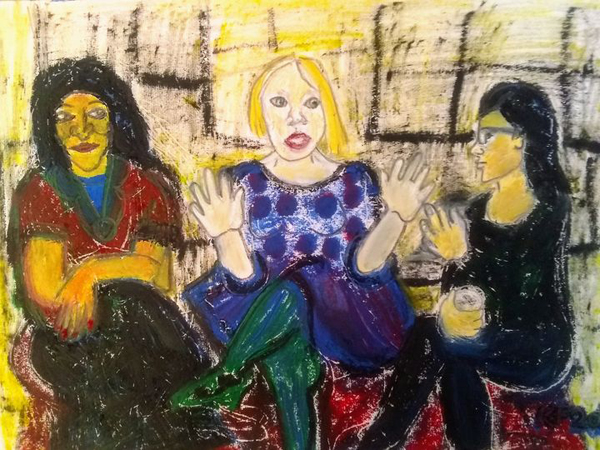 The Conversation, 2020, (Nalini, Shona and Jo), Oil Pastel, Graphite, Papermate 10 in x 14 in
The Conversation, 2020, (Nalini, Shona and Jo), Oil Pastel, Graphite, Papermate 10 in x 14 in
Kofi Fosu Forson is a writer, poet and playwright. He explores subjects of post-transformative conscience(s), transcendence in art, gender and ethnic politics. His current poetry manuscript, Ghost of Brother Blackburn and Other Poems, was shortlisted by Broken Sleep Press.
